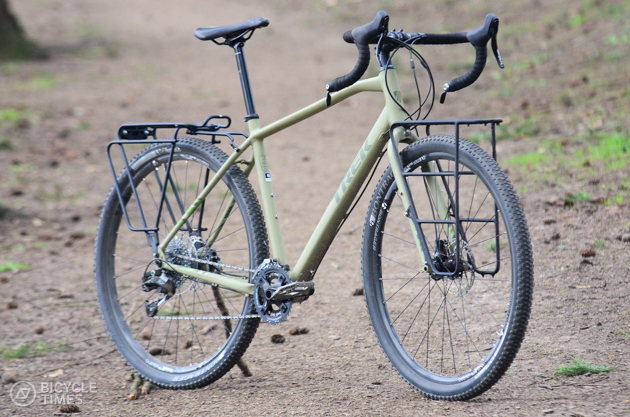Review: Trek 920 Disc
Originally posted on November 19, 2015 at 13:55 pmFrom Issue #37
Bicycle touring has changed a lot over the past few years, and while riders once rejoiced for a smooth ribbon of asphalt, a rough and rocky road is now de rigueur. Right on the Trek website you see signs of this preference as the new 920 Disc is classified under the banner of “touring and adventure,” and it’s clearly been designed to peg the needle at the latter end of that dial.

I have to say, the matte green paint and knobby tires look pretty badass, like something you’d expect to see with CALL OF DUTY EDITION stenciled on the side. Besides its looks the main draw of the 920 is of course the wheels and tires, which are straight out of the Bontrager mountain bike catalog: duster elite tubeless ready 29-inch wheels with thru-axles front and rear and XR1 29×2.0 tires. There is ample clearance for a 29×2.2 or a set of fenders with the stock tires.
When not exploring the back roads of the Wild West, the 920 Disc would make an excellent commuter. The build powering those big wheels is a Sram 10-speed drivetrain with 42/28 chainrings and an 11-36 cassette, also borrowed from a mountain bike. Old-school bike tourists will appreciate the bar-end shifters, though I wish the modern SRAM versions could be switched to friction mode. The double chainrings are more than adequate for most riding, but don’t offer a huge range. This might be the first bike I’ve ridden where I was wishing for a little bit lower gear and a higher gear; usually it’s just one or the other.

Built from Trek’s 100 Series Alpha Aluminum, the frame’s tubing is aggressively shaped with a massive downtube and a distinctly kinked top tube. That kink makes room for a second bottle cage on the top of the down tube on frames size 56 and up, for a total of four on the main triangle. There are also bottle cage mounts on each fork leg that do double duty as the front rack mount. In fact, the 920 Disc includes both front and rear Bontrager aluminum racks. While the rear rack is a fairly conventional design, the front rack sits up a bit higher than a set of traditional low-riders, though with the panniers mounted on the second bar from the top the bike handles just fine with plenty of toe clearance.

Bringing it all to a halt is a pair of TRP’s Hylex hydraulic disc brakes, which stand out for their stopping power but are also distinctive for their ergonomics. The main body of the lever houses the master cylinder, and to make room they are quite long. So much so that if you swapped these onto another bike, you’d have to shorten the stem by 10 mm or so to compensate to achieve the same reach to the hoods. The compact bend of the handlebar keeps things pretty comfortable though. I also swapped out the stock stem for a shorter one to dial in a perfect fit.
I loaded the 920 up with panniers and hit the pavement for a 100-mile overnight road ride, and then ditched the racks for some forest road exploring. It’s perhaps a bit too heavy for all-out gravel racing, but I found it’s an excellent companion for all-day back road explorations and dirt road rambling. Despite the aluminum frame, the big tires are more than enough to soak up the road vibrations, and the Bontrager saddle and I got along just fine.

While the basic layout of the 920 Disc is fairly traditional, the details are anything but. Shift cables run internally and the frame is equipped with a port for the Trek DuoTrap S speed and cadence sensor system. The hydraulic brakes might scare off some traditionalists, but they are much appreciated when you’re careening down a mountain with 70 pounds of gear. Purists will also scoff at the notion of an aluminum frame and fork on a touring bike, but if you really think you need a frame that can somehow be pieced back together on the side of the road by a good samaritan with a blowtorch in Uzbekistan, so be it. But I doubt you do.
The other refrain I’ve seen echoing through the message boards is that Trek copied the Salsa Fargo, as if that were the first bike with 29-inch tires and drop bars. While the Salsa is at heart a mountain bike and can run a suspension fork, the 920 Disc isn’t meant for singletrack. Think of it more as a Subaru Outback than a Jeep Wrangler.

The stock tires are most at home on double-track or gravel, but they roll well enough that I left them on for road rides as well. Because they are tubeless ready the bead sits incredibly tight on the rim and fixing a flat requires very high air pressure, some strong thumbs and a bit of cursing to get the tires to seat properly. I recommend setting them up tubeless from the beginning to shed weight and eliminate pinch flats.
While the 920 is meant for more rough and tumble adventures rather than smooth pavement, I would still choose it over the classic Trek 520 model for traditional road touring. My mountain bike experience has made me a big fan of hydraulic disc brakes and thru-axles—modern features that have earned my trust. Whether you go slicks or knobbies, with racks or without, the 920 Disc is a versatile bike that is ready for your next adventure.

Details
- Price: $2,090
- Weight: 24.8 pounds (without racks), 27.5 pounds (with racks)
- Sizes: 49, 52, 54, 56, 58 (tested) and 61 cm
- More: trekbikes.com